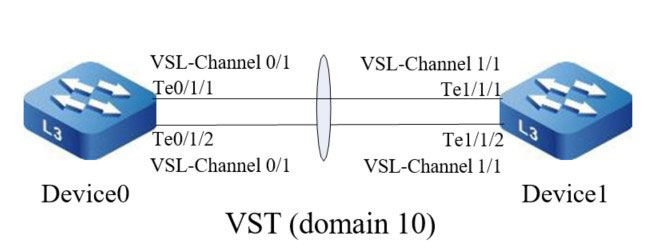Network Requirement
- Device0, and Device1 form the link stacking system; Device0 becomes the control device.
Network Topology

Figure 1-2 Configure devices to form the link stacking system
Configuration Steps
Step 1: Configure Device0.
#On Device0, configure the virtual switching member device number as 0, configure the domain number as 10, and the priority is 255.
|
Device0#configure terminal
Device0(config)#switch virtual member 0
Do you want to modify member id(Yes|No)?y
% Member ID 0 config will take effect only after the exec command 'switch mode virtual' is issued
Device0(config-vst-member-0)#domain 10
% Domain ID 10 config will take effect only after the exec command 'switch mode virtual' is issued
Device0(config-vst-member-0)#priority 255
Device0(config-vst-member-0)#exit
|
#On Device0, create virtual switch link interface 1 and add port tengigabitethernet1/1 and tengigabitethernet1/2 to the virtual switch link interface 1.
|
Device0(config)#vsl-channel 1
Device0(config-vsl-channel-1)#exit
Device0(config)#interface tengigabitethernet 1/1-1/2
Device0(config-if-range)#vsl-channel 1 mode on
Device0(config-if-range)#exit
|
#Save the configuration on Device0.
|
Device0#write
Are you sure to overwrite /flash/startup (Yes|No)?y
Building Configuration...done
Write to startup file OK
Write to mode file OK
|
Step 2: Configure Device1.
#On Device1, configure the virtual switching member device number as 1, configure the domain number as 10, and the priority is 200.
|
Device1#configure terminal
Device1(config)#switch virtual member 1
Do you want to modify member id(Yes|No)?y
% Member ID 1 config will take effect only after the exec command 'switch mode virtual' is issued
Device1(config-vst-member-1)#domain 10
% Domain ID 10 config will take effect only after the exec command 'switch mode virtual' is issued
Device1(config-vst-member-1)#priority 200
Device1(config-vst-member-1)#exit
|
#On Device1, create virtual switch link interface 1 and add port tengigabitethernet0/1 and tengigabitethernet0/2 to the virtual switch link interface 1.
|
Device1(config)#vsl-channel 1
Device1(config-vsl-channel-1)#exit
Device1(config)#interface tengigabitethernet 0/1-0/2
Device1(config-if-range)#vsl-channel 1 mode on
Device1(config-if-range)#exit
|
#On Device1, save the configuration.
|
Device1#write
Are you sure to overwrite /flash/startup (Yes|No)?y
Building Configuration...done
Write to startup file... OK
Write to mode file... OK
|
Step 3: Configure the running mode of Device0 and Device1 as the VST mode.
#Configure the running mode of Device0 as the VST mode.
Device0#switch mode virtual
This command will convert all interface names to naming convention "interface-type member-number/slot/interface" ,
Please make sure to save current configuration.Do you want to proceed? (yes|no)?y
Converting interface names Building configuration
Copying the startup configuration to backup file named "startup-backupalone"
Please wait system reloading is in progress!
ok
Reset system!
Jul 30 2014 17:36:14: %SYS-5-RELOAD: Reload requested
#Configure the running mode of Device1 as the VST mode.
Device1#switch mode virtual
This command will convert all interface names to naming convention "interface-type member-number/slot/interface" ,
Please make sure to save current configuration.Do you want to proceed? (yes|no)?y
Converting interface names Building configuration
Copying the startup configuration to backup file named "startup-backupalone"
Please wait system reloading is in progress!
ok
Reset system!
Jul 30 2014 17:36:20: %SYS-5-RELOAD: Reload requested
Step 4: Check the result.
#On Device0, the VST system is formed and Device0 is the master device.
Device0#show switch virtual
Codes: L - local-device,I isolate-device
Virtual Switch Mode : VIRTUAL
Virtual Switch DomainId : 10
Virtual Switch mac-address.. 0001.7a6a.001b
---------------VST MEMBER INFORMATION--------------------
CODE MemberID Role Pri LocalVsl RemoteVsl
L 0 Master 255 vsl-channel 0/1 vsl-channel 1/1
1 Member 200 vsl-channel 1/1 vsl-channel 0/1
 Switch
Switch Wifi - Access Point
Wifi - Access Point Firewall
Firewall Router
Router Module Quang
Module Quang![Module Quang Cisco]() Module Quang Cisco
Module Quang Cisco![Module quang HPE]() Module quang HPE
Module quang HPE![Module quang Maipu]() Module quang Maipu
Module quang Maipu![Module quang Brocade]() Module quang Brocade
Module quang Brocade![Module quang Fortinet]() Module quang Fortinet
Module quang Fortinet![Module quang Aruba]() Module quang Aruba
Module quang Aruba![Module quang OEM]() Module quang OEM
Module quang OEM![Module quang Juniper]() Module quang Juniper
Module quang Juniper![Module quang Dell]() Module quang Dell
Module quang Dell![Module quang Palo Alto]() Module quang Palo Alto
Module quang Palo Alto![Module quang Huawei]() Module quang Huawei
Module quang Huawei![Module quang Arista]() Module quang Arista
Module quang Arista![Module quang F5]() Module quang F5
Module quang F5![Module quang H3C]() Module quang H3C
Module quang H3C![Module Quang Allied Telesis]() Module Quang Allied Telesis
Module Quang Allied Telesis![Module quang SonicWall]() Module quang SonicWall
Module quang SonicWall![Module quang Mikrotik]() Module quang Mikrotik
Module quang Mikrotik![Module quang Handar]() Module quang Handar
Module quang Handar Máy chủ (Server)
Máy chủ (Server) Thiết bị lưu trữ (SAN, NAS)
Thiết bị lưu trữ (SAN, NAS) Load Balancing
Load Balancing Video Conferencing
Video Conferencing Phụ kiện máy chủ
Phụ kiện máy chủ Thiết Bị IoT
Thiết Bị IoT Phụ Kiện Mạng
Phụ Kiện Mạng




.png)
























